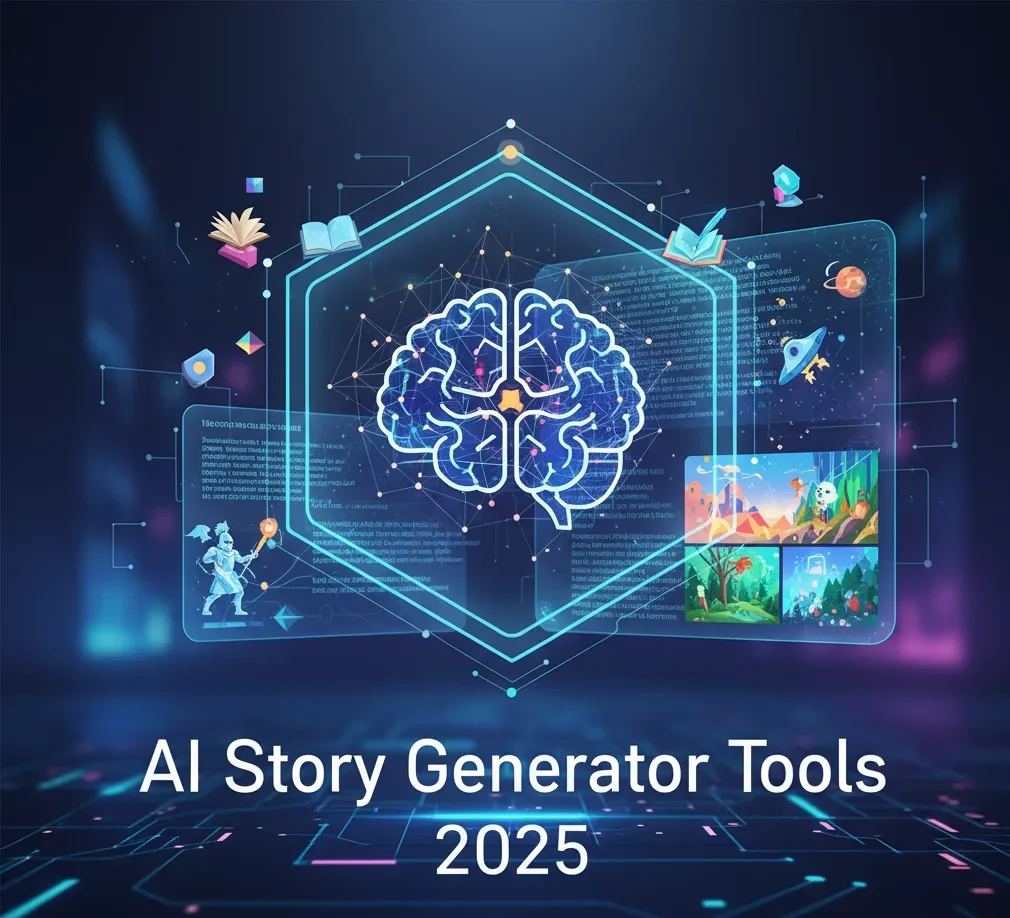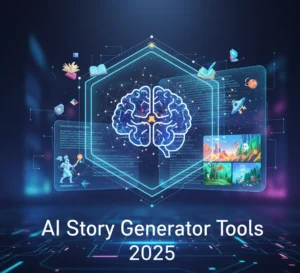AI Story Generator Tools 2025: The Next Big Leap in Digital Storytelling
October 07, 2025 | Gudstory Org AI News
Thank you for reading this post, don't forget to subscribe!The landscape of digital storytelling is experiencing a seismic shift. As we navigate through 2025, artificial intelligence story generator tools have evolved from experimental novelties into sophisticated creative partners that are fundamentally transforming how content is created, consumed, and commercialized across industries.
The Evolution of AI Storytelling in 2025
The AI story generation market has matured dramatically over the past year. What began as simple text generators producing generic narratives has blossomed into a sophisticated ecosystem of tools capable of crafting everything from short fiction to full-length novels, screenplays, and interactive narratives with remarkable coherence and creativity.
The aesthetic of AI-generated content has shifted significantly toward more organic and human-feeling output, moving away from the overly polished, uncanny quality that marked earlier generations. Today’s tools blend AI assistance with human creativity rather than attempting to replace the storyteller entirely.
Why 2025 is the Breakthrough Year
Several factors have converged to make 2025 a watershed moment for AI story generation:
Enhanced Natural Language Understanding
Modern AI story generators leverage advanced language models that understand context, character development, plot structure, and narrative arc with unprecedented sophistication. These tools can maintain consistent character voices, build compelling story arcs, and adapt tone and style to match specific genres or audiences.
Multi-Modal Storytelling
AI models now achieve near-cinematic quality in visual generation, with smooth transitions, lifelike textures, and dynamic lighting, enabling creators to generate not just text but accompanying visuals that enhance the storytelling experience.
Democratization of Creative Content
Perhaps most significantly, AI story generators have removed traditional barriers to creative expression. Writers no longer need extensive training or years of experience to produce professional-quality narratives. These tools offer novel solutions for breaking through writer’s block, enabling creators to generate stories, produce more content, and experiment with different storytelling approaches.
Top AI Story Generator Tools Dominating 2025
Jasper AI: The All-in-One Powerhouse
Jasper AI has established itself as the comprehensive solution for content creators tackling diverse storytelling needs. From marketing narratives to creative fiction, Jasper offers sophisticated templates, tone adjustments, and brand voice customization that makes it invaluable for both commercial and creative applications.
Key Features:
- Advanced plot development algorithms
- Multi-genre specialization
- Team collaboration capabilities
- Brand voice consistency tools
- Integration with major content management systems
Best For: Marketing teams, content agencies, and professional authors managing multiple projects
Squibler: The Novelist’s Companion
Squibler has emerged as the go-to platform for long-form fiction writers. Its AI can generate entire books, maintain character consistency across chapters, and help writers structure complex narratives while keeping them in the driver’s seat.
Key Features:
- Full-length novel generation
- Chapter-by-chapter editing
- Character profile management
- Plot hole detection
- Manuscript formatting tools
Best For: Novelists, screenwriters, and serious fiction authors
Writesonic: The Research-Driven Storyteller
Writesonic distinguishes itself through its research capabilities, allowing creators to generate well-informed narratives backed by real-world data. The platform can even convert written stories into audiobook format, addressing the growing demand for audio content.
Key Features:
- Integrated research tools
- Fact-checking capabilities
- Audio content generation
- SEO optimization for web content
- Multi-language support
Best For: Non-fiction writers, educational content creators, and multimedia storytellers
Rytr: The Budget-Friendly Option
Rytr proves that powerful AI storytelling doesn’t require enterprise budgets. With affordable pricing tiers and robust features, it’s making AI-assisted writing accessible to independent creators and small businesses.
Key Features:
- Cost-effective pricing
- Multiple use case templates
- Tone variation controls
- Plagiarism checker
- Browser extension for on-the-go writing
Best For: Freelancers, small businesses, and budget-conscious creators
DreamGen: Bridging Serious and Playful Writing
DreamGen occupies a unique space in the market, serving both serious fiction writers and those exploring more experimental, playful storytelling formats. Its versatility makes it ideal for writers who want flexibility in their creative process.
Key Features:
- Flexible narrative controls
- Genre-blending capabilities
- Interactive story elements
- Community sharing features
- Customizable AI behavior
Best For: Experimental writers, game narrative designers, and creative hobbyists
Applications Transforming Industries
Content Marketing and Brand Storytelling
According to recent industry data, email marketing newsletters, text-based social media content, blog posts, and SEO-focused content are among the top applications for AI-generated material. Brands are leveraging AI story generators to maintain consistent publishing schedules, test different narrative approaches, and personalize content at scale.
Entertainment and Media Production
Studios and production companies are using AI story generators for script development, plot ideation, and even dialogue refinement. In interactive media like video games, AI-driven narratives adapt based on player choices, creating unique and personalized storytelling experiences.
Education and Training
Educational institutions are employing AI story generators to create engaging learning materials, case studies, and simulation scenarios that make complex concepts more accessible and memorable.
Publishing Industry Revolution
Traditional publishing is experiencing disruption as AI tools enable rapid content production. While concerns about quality and authenticity persist, forward-thinking publishers are exploring hybrid models that combine AI efficiency with human editorial oversight.
The Human-AI Collaboration Model
Rather than replacing storytellers entirely, the most successful applications of AI in storytelling involve collaboration between human creativity and machine capability. This partnership model leverages AI’s strengths—speed, consistency, pattern recognition—while preserving human judgment, emotional intelligence, and creative vision.
The most effective workflow in 2025 involves:
- Human-Led Ideation: Writers define core concepts, themes, and emotional goals
- AI-Assisted Development: Tools generate multiple variations and expand on ideas
- Human Curation: Creators select, refine, and inject authentic voice
- AI Optimization: Tools polish language, check consistency, and suggest improvements
- Human Final Review: Writers ensure the work meets creative and ethical standards
Challenges and Considerations
Authenticity and Originality
As AI-generated content floods digital spaces, readers are becoming more discerning. Content that feels generic or lacks genuine human insight faces rejection. Successful creators use AI as a starting point while ensuring their unique perspective shines through.
Ethical and Copyright Concerns
The industry continues grappling with questions about ownership, attribution, and the ethics of AI-trained models. Most professional tools now include features to ensure originality and avoid plagiarism, but users must remain vigilant.
The Quality Spectrum
Not all AI-generated content is created equal. While top-tier tools produce impressive results, lower-quality outputs can still feel formulaic or lack depth. Critical evaluation and editing remain essential skills.
Transparency Requirements
In 2025, consumers increasingly demand transparency from companies about where they use AI in customer interactions. Publishers and content creators are establishing disclosure policies to maintain trust with audiences.
Best Practices for Using AI Story Generators in 2025
Start with Strong Prompts
The quality of AI-generated stories depends heavily on input quality. Effective prompts include:
- Clear genre and tone specifications
- Detailed character descriptions
- Specific plot points or themes
- Target audience information
- Desired length and structure
Maintain Your Voice
Use AI tools to amplify your voice, not replace it. Edit generated content to ensure it reflects your unique perspective, style, and values.
Iterate and Refine
Rarely will first-generation AI output meet publication standards. Plan for multiple rounds of generation, selection, and refinement.
Combine Multiple Tools
Different AI story generators excel at different tasks. Consider using specialized tools for research, drafting, editing, and optimization.
Stay Informed on Capabilities
AI technology evolves rapidly. Tools that struggled with certain narrative elements six months ago may now handle them expertfully. Regularly explore new features and capabilities.
The Future: What’s Next for AI Storytelling
Personalization at Scale
Emerging tools will enable stories that adapt to individual reader preferences in real-time, creating truly personalized narrative experiences.
Emotional Intelligence
Next-generation AI will better understand and replicate emotional nuance, creating stories that resonate more deeply with human readers.
Cross-Platform Integration
Expect seamless integration between story generators and publishing platforms, social media, and content management systems, streamlining the creation-to-publication pipeline.
Enhanced Collaboration Features
Future tools will facilitate better teamwork, allowing multiple creators and AI assistants to collaborate on single projects with improved version control and contribution tracking.
Regulatory Frameworks
As the technology matures, expect clearer legal and ethical guidelines governing AI-generated content, providing creators and consumers with better protection and clarity.
Making the Best Choice: Which Tool is Right for You?
Selecting the right AI story generator depends on your specific needs:
Choose Jasper AI if: You need comprehensive marketing and creative content capabilities with team collaboration features.
Choose Squibler if: You’re writing long-form fiction and need robust organizational and continuity tools.
Choose Writesonic if: Research accuracy and multi-format output (including audio) are priorities.
Choose Rytr if: Budget constraints are a concern but you still need reliable AI assistance.
Choose DreamGen if: You value flexibility and want to experiment with different storytelling styles.
Many successful creators maintain subscriptions to multiple tools, using each for its particular strengths within their overall workflow.
Conclusion: Embracing the AI Storytelling Revolution
AI story generator tools in 2025 represent more than technological advancement—they’re catalyzing a fundamental democratization of creative expression. While concerns about authenticity, quality, and ethics remain important considerations, the tools themselves are neutral technologies whose impact depends entirely on how we choose to use them.
The most successful storytellers of 2025 aren’t those who resist AI or rely on it completely. They’re the creators who understand how to blend machine capability with human creativity, using AI to overcome obstacles, expand possibilities, and reach audiences in ways previously impossible.
As these tools continue evolving, one thing remains certain: the future of storytelling isn’t about AI versus humans—it’s about humans empowered by AI creating richer, more diverse, and more accessible narratives than ever before.
The next big leap in digital storytelling isn’t coming. It’s already here. The only question is: how will you use it to tell your story?


